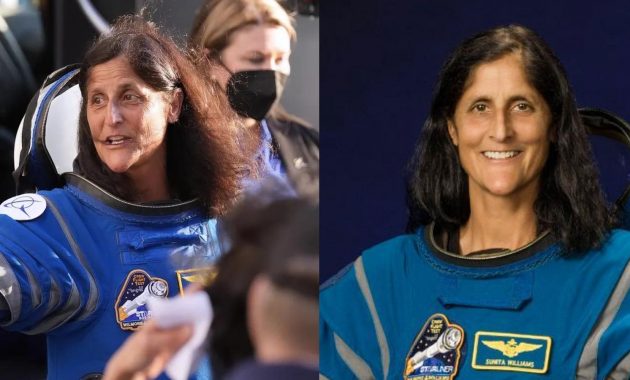Astronaut Sunita Williams, who is stuck in space for over 50 days on a mission, has reportedly experienced loss of muscle mass and bone density. Know more about the health concerns of being stuck in space.
When astronauts take up missions into space, they expose themselves to an environment that is extremely different from Earth. Factors like microgravity, restricted space station quarters, isolation, and radiation exposure pose unique challenges to human health. Even though the secrets they unveil about space are worth knowing, even small missteps can lead to grave circumstances when it comes to the health of astronauts. Prolonged stays, just like the unexpected extension of Sunita Williams and Barry Wilmore’s mission on the International Space Station (ISS), bring to the surface the health risks astronauts face.
What happened to Sunita Williams?
Indian-origin astronaut Sunita Williams, who joined NASA in 1998 and is a veteran of two space missions, is currently serving as the pilot of the Crew Flight Test mission aboard Boeing’s Starliner spacecraft. While it is her third mission aboard the International Space Station, she is reportedly experiencing loss of bone density and muscle mass, after being in space for over 50 days when the mission was initially set for 9 days.
Sunita Williams and Barry Wilmore are going through an extension of stay on the International Space Station due to unexpected delays. Launched on May 25, 2024, the spacecraft encountered a small helium leak that delayed its return journey. The Starliner’s return has been postponed twice, with no confirmation of the fresh dates yet. However, as per NASA, regular health checkups are being done and the crew members are ensuring they do their bit of physical activity up in space.
Check out a glimpse here!
Why does loss of bone density and muscle mass happen in space?
Microgravity also has effects on the musculoskeletal system. Our muscle support requires gravity, but astronauts experience faster muscle atrophy, especially in the legs and back. The effect gets compounded by drastic muscle loss, especially in weight-bearing bones like the spine and pelvis. There is also a loss in bone density due to a lack of mechanical stress, similar to osteoporosis.
Bones require mechanical stress to maintain density and strength. On Earth, gravity constantly pulls against our muscles, compelling them to work to support our bodies and move around. In microgravity, this constant load is absent, leading to reduced muscle use. It weakens the skeletal system and muscles, which leads to the breakdown of bone tissue, commonly known as bone resorption. The absence of gravity leads to a rapid decrease in both muscle mass and bone density, resembling conditions like Osteoporosis or thinning of bone tissue, which can increase the risk of fractures. Hence, it is important for astronauts, especially on missions for long-duration to understand the side effects of microgravity and address them through correct measures, orthopedic Dr Swapnil Keny tells Health Shots.
Select Topics of your interest and let us customize your feed.
PERSONALISE NOW
How to avoid muscle mass in space?
Following a proper exercise regime with specialized equipment can help in maintaining bone density and muscle mass in microgravity. A well-planned diet that includes enough vitamin D, Calcium, and other nutrients, is also essential to fulfil the requirements of the bones.
Spacewalks should be planned during low solar activity periods and the astronaut should make use of spacecraft shielding to reduce radiation exposure. Along with this measure, astronauts should regularly monitor their health parameters for early detection and treatment of any health issues. This will not only help reduce the risk of bone health issues but will also help ensure overall well-being during the stay in space, adds Dr Keny.
Even though rigorous exercise routines have been formed on the ISS to mitigate the side effects of the change in environment, some degree of risk of bone loss remains inevitable.

Other side effects that astronauts in space may face
While astronauts head into space with complete planning, such prolonged stays could impact their health in multiple ways.
1. Fluid redistribution
One of the most significant and earliest changes astronauts go through is the distribution of fluid due to microgravity. Without the constant pull of gravity, fluids tend to shift to the upper parts of the body leading to facial puffiness, nasal congestion, and loss of fluid volume in the legs. This can lead to a reduction in blood volume and alter blood pressure regulation. As a result, when astronauts return to Earth, they might suffer from orthostatic intolerance which includes symptoms like dizziness and fainting while standing up.
Also read: These 5 beginner-friendly tips will help you build muscle mass of your dreams
2. Elevated risk of kidney stones
The changes in fluid distribution can also have an impact on the urinary system. High calcium levels in urine can increase the risk of kidney stones. Microgravity has an impact on metabolism that affects how nutrients are absorbed and utilized in the body. Hormonal changes, insulin sensitivity, and changes in the composition of gut microbiota are some of the major health risks observed in the long term.
3. Sensory and neurological changes
The lack of gravity can also impact sensory input, disrupting spatial orientation, eye-hand coordination, and balance. Space motion sickness (SMS) is yet another health impact that astronauts experience when they first arrive in space. Symptoms like nausea, vomiting, and disorientation are commonly observed. Although the gravity of the symptoms declines as their body gets accustomed, microgravity continues to affect neurological functions throughout their stay.
4. Long-term risks of radiation exposure
The presence of astronauts in space leaves them exposed to higher levels of radiation than Earth. The radiation, which includes galactic cosmic rays and solar particle events, can make astronauts prone to health risks like DNA damage and increased chances of getting cancer. Space agencies meticulously monitor and set limits on exposure to radiation to make sure that it remains at safe levels throughout multiple missions.
#Sunita #Williams #loses #muscle #mass #bone #density #space

